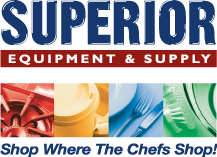Posted on December 22 2023

Your grease trap is one of your kitchen’s most valuable assets, keeping it clean is essential. A grease trap is probably isn't the most exciting piece of equipment in your restaurant, take-out, or other commercial food kitchen. However, it also may be one of the most important. A malfunctioning grease trap can impact your customers' experience, your employees' working environment, the effect of your operation on the local community, and your business's standing with health and safety regulatory agencies.
What Is a Grease Trap? A grease trap, also sometimes known as a grease interceptor, is a plumbing fixture designed to catch the fats, oils, and greases (FOG) produced in food processing and often washed down the drain. Grease traps can be small affairs located inside, often around the sink area. Or they can be large exterior traps, often underground, capable of holding hundreds to thousands of gallons.
How Do They Work? Wastewater carrying FOG flows from your kitchen's drains into the grease trap's tank. There, the FOG rises to the top of the tank and is kept by a baffles system from flowing with the water into the sewer pipes.
What Happens if the Grease Trap Is Not Well Maintained? A clogged or otherwise malfunctioning grease trap can have deleterious effects on all aspects of your food operation. It can:
- Emit a stench that doesn't disappear no matter how much you clean
- Cause drain clogs and sewage overflows in your establishment, requiring expensive repairs and remediation
- Bring about regulatory penalties and even business closures
- Lead to FOG and other contaminated wastewater overflow entering the sewer pipes and polluting local groundwater
What Can I Do to Avoid a Non-Maintained Trap? On a day-to-day basis, there are a number of steps you can take to keep your grease trap in top working order. These include:
- Don't pour grease down the drain but instead collect it in bins disposed of by a waste management contractor.
- Scrape plates before rinsing to further remove grease.
- Install screens under the drains in your sinks to catch FOG before it enters the pipes.
- Use disposals for non-greasy foods only.
- Wipe up grease spills with a paper towel to keep as much FOG as possible away from the drain.
- Train employees in appropriate grease management practices.
- Have your grease trap inspected and cleaned regularly by experienced technicians familiar with your local health, safety, and environmental regulations.
How Do I Know When I Need to Have the Grease Trap Cleaned?
How often to call in the professionals to clean your grease trap depends on its size and the extent of your kitchen operation. However, the time between cleanings should never exceed three months. Signs that you might need more frequent service include:
- Blocked pipes or foul smells
- Levels in your grease trap tank more than 25 % FOG
- Grease leaked onto floors and surfaces
Clogs often happen in busy kitchens when owners and operators pour hot dirty grease down a drain during a busy rush. When that hot liquid cools or hits cold water and solidifies causing pipes to get clogged. Many cities require grease traps to be used in commercial kitchens due to the critical role they play in preventing costly sewer problems.
A grease trap can help eliminate unfortunate scenarios like these. Grease traps play a critical role in keeping a restaurant kitchen and other food service businesses running smoothly by eliminating clogs and keeping plumbing systems functioning properly. They work to separate the waste from the water so businesses can dispose of the used oil, grease and other fats.
For a grease trap to function as intended, it needs to be properly maintained. Here are some important grease trap maintenance tips from the product specialists at Superior Equipment.
By having your trap regularly cleaned, you prevent the trap from overflowing and avoid expensive plumbing bills. Regularly cleaning your trap also reduces odors, which can be off-putting to your customers.
Smaller grease traps are typically cleaned out by employees on a weekly basis. Cleaning is needed more or less frequently depending on the size of the trap and how much waste grease is produced in the kitchen.
Employees can manually scoop or vacuum solidified grease out of the trap to clean it. If liquid grease remains, pour it into a container or remove with an absorbent material.
Larger grease traps can be more complex to clean, and restaurants with these systems will typically hire a professional to remove, clean and recycle oils.
Always keep records of when your grease trap is cleaned for easy reference.
Encourage staff to be mindful of how grease and oils are being disposed of, set up guidelines and post in appropriate locations in the kitchen.
Maintaining your grease trap is an important part of managing your restaurant and there are important steps you can take to control build up. Preventing environmental consequences, lengthy cleaning processes and added costs will ultimately foster a safe and productive environment for both your employees and customers.
Do you have questions about grease trap maintenance or thinking of purchasing a new unit? Call the food service experts at 414-671-1200


0 comments
Related Posts
How to Control Your Food Costs in Restaurants
Which Commercial Kitchen Layout is Right for Your Restaurant?
Great Tools Make Great Food